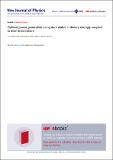Files in this item
Optimal power generation using dark states in dimers strongly coupled to their environment
Item metadata
| dc.contributor.author | Rouse, Dominic Michael | |
| dc.contributor.author | Gauger, Erik | |
| dc.contributor.author | Lovett, Brendon W | |
| dc.date.accessioned | 2019-06-21T09:30:03Z | |
| dc.date.available | 2019-06-21T09:30:03Z | |
| dc.date.issued | 2019-06-20 | |
| dc.identifier | 259221062 | |
| dc.identifier | b990c2bd-c352-4ed0-b735-93f9bd982dca | |
| dc.identifier | 85070543387 | |
| dc.identifier | 000516856800001 | |
| dc.identifier.citation | Rouse , D M , Gauger , E & Lovett , B W 2019 , ' Optimal power generation using dark states in dimers strongly coupled to their environment ' , New Journal of Physics , vol. 21 , 063025 . https://doi.org/10.1088/1367-2630/ab25ca | en |
| dc.identifier.issn | 1367-2630 | |
| dc.identifier.other | Bibtex: urn:5f1b27ff7df8ce03d17e4564ba255198 | |
| dc.identifier.other | ORCID: /0000-0001-5142-9585/work/58755503 | |
| dc.identifier.uri | https://hdl.handle.net/10023/17939 | |
| dc.description | D.R. acknowledges studentship funding from EPSRC under grant no. EP/L015110/1. E.M.G. thanks the Royal Society of Edinburgh and the Scottish Government for support. | en |
| dc.description.abstract | Dark state protection has been proposed as a mechanism to increase the power output of light harvesting devices by reducing the rate of radiative recombination. Indeed many theoretical studies have reported increased power outputs in dimer systems which use quantum interference to generate dark states. These models have typically been restricted to particular geometries and to weakly coupled vibrational baths. Here we consider the experimentally-relevant strong vibrational coupling regime with no geometric restrictions on the dimer. We analyze how dark states can be formed in the dimer by numerically minimizing the emission rate of the lowest energy excited eigenstate, and then calculate the power output of the molecules with these dark states. We find that there are two distinct types of dark states depending on whether the monomers form homodimers, where energy splittings and dipole strengths are identical, or heterodimers, where there is some difference. Homodimers, which exploit destructive quantum interference, produce high power outputs but strong phonon couplings and perturbations from ideal geometries are extremely detrimental. Heterodimers, which are closer to the classical picture of a distinct donor and acceptor molecule, produce an intermediate power output that is relatively stable to these changes. The strong vibrational couplings typically found in organic molecules will suppress destructive interference and thus favor the dark-state enhancement offered by heterodimers. | |
| dc.format.extent | 28 | |
| dc.format.extent | 2012403 | |
| dc.language.iso | eng | |
| dc.relation.ispartof | New Journal of Physics | en |
| dc.subject | Dark state protection | en |
| dc.subject | Light harvesting | en |
| dc.subject | Polaron transform | en |
| dc.subject | Organic solar cell | en |
| dc.subject | Quantum heat engine | en |
| dc.subject | QC Physics | en |
| dc.subject | DAS | en |
| dc.subject.lcc | QC | en |
| dc.title | Optimal power generation using dark states in dimers strongly coupled to their environment | en |
| dc.type | Journal article | en |
| dc.contributor.sponsor | EPSRC | en |
| dc.contributor.institution | University of St Andrews. School of Physics and Astronomy | en |
| dc.contributor.institution | University of St Andrews. Condensed Matter Physics | en |
| dc.identifier.doi | https://doi.org/10.1088/1367-2630/ab25ca | |
| dc.description.status | Peer reviewed | en |
| dc.identifier.grantnumber | EP/L015110/1 | en |
This item appears in the following Collection(s)
Items in the St Andrews Research Repository are protected by copyright, with all rights reserved, unless otherwise indicated.

